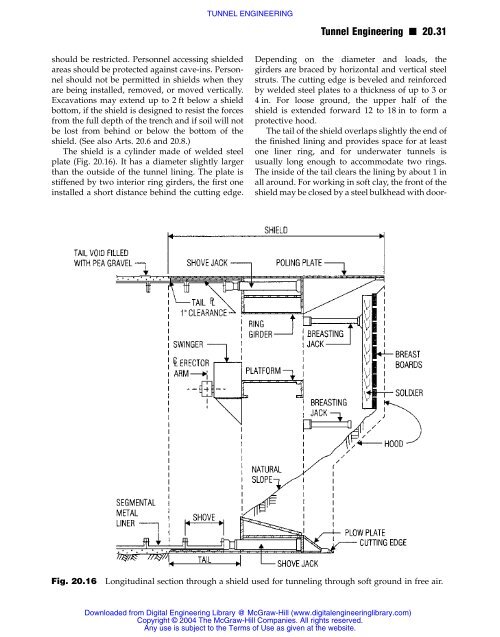TUNNEL ENGINEERING
TUNNEL ENGINEERING
TUNNEL ENGINEERING
You also want an ePaper? Increase the reach of your titles
YUMPU automatically turns print PDFs into web optimized ePapers that Google loves.
should be restricted. Personnel accessing shielded<br />
areas should be protected against cave-ins. Personnel<br />
should not be permitted in shields when they<br />
are being installed, removed, or moved vertically.<br />
Excavations may extend up to 2 ft below a shield<br />
bottom, if the shield is designed to resist the forces<br />
from the full depth of the trench and if soil will not<br />
be lost from behind or below the bottom of the<br />
shield. (See also Arts. 20.6 and 20.8.)<br />
The shield is a cylinder made of welded steel<br />
plate (Fig. 20.16). It has a diameter slightly larger<br />
than the outside of the tunnel lining. The plate is<br />
stiffened by two interior ring girders, the first one<br />
installed a short distance behind the cutting edge.<br />
<strong>TUNNEL</strong> <strong>ENGINEERING</strong><br />
Tunnel Engineering n 20.31<br />
Depending on the diameter and loads, the<br />
girders are braced by horizontal and vertical steel<br />
struts. The cutting edge is beveled and reinforced<br />
by welded steel plates to a thickness of up to 3 or<br />
4 in. For loose ground, the upper half of the<br />
shield is extended forward 12 to 18 in to form a<br />
protective hood.<br />
The tail of the shield overlaps slightly the end of<br />
the finished lining and provides space for at least<br />
one liner ring, and for underwater tunnels is<br />
usually long enough to accommodate two rings.<br />
The inside of the tail clears the lining by about 1 in<br />
all around. For working in soft clay, the front of the<br />
shield may be closed by a steel bulkhead with door-<br />
Fig. 20.16 Longitudinal section through a shield used for tunneling through soft ground in free air.<br />
Downloaded from Digital Engineering Library @ McGraw-Hill (www.digitalengineeringlibrary.com)<br />
Copyright © 2004 The McGraw-Hill Companies. All rights reserved.<br />
Any use is subject to the Terms of Use as given at the website.
















